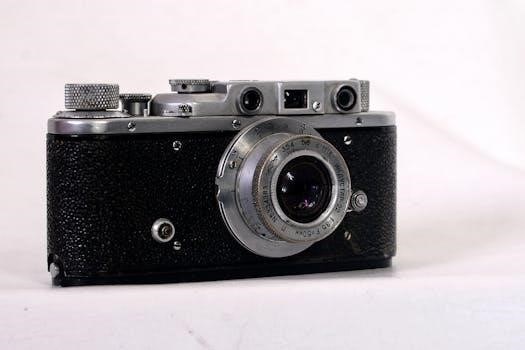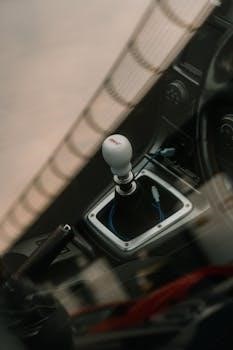Alfa Romeo 4C⁚ The Manual Gearbox Question
The Alfa Romeo 4C, a lightweight sports car, sparks debate among enthusiasts․ A key point of contention is the absence of a manual gearbox option․ Many purists believe a three-pedal setup would enhance the driving experience․ The question remains⁚ why no manual?
The Alfa Romeo 4C, a beacon of focused Italian sports car design, ignites passion with its lightweight construction and raw driving experience․ Yet, a persistent question lingers within enthusiast circles⁚ why wasn’t a manual transmission offered? The allure of a manual gearbox in a car like the 4C is deeply rooted in the desire for tactile purity and complete driver engagement․
For many, the act of physically engaging gears, managing the clutch, and precisely controlling the engine’s power delivery is integral to the sports car experience․ It’s a connection to the machine that transcends mere transportation, transforming driving into an art form․ A manual transmission offers a level of control and involvement that some argue a dual-clutch automatic, however sophisticated, cannot replicate․
The 4C, with its lack of power steering and focus on minimizing weight, already embodies a commitment to old-school driving feel․ The absence of a manual option, therefore, feels like a missed opportunity to achieve tactile purity․ It’s a deficit that, for some, detracts from the overall experience, leaving them yearning for the directness and involvement that only a manual gearbox can provide․

The Reality⁚ Alfa Romeo 4C and the TCT Transmission
Despite the desires of some enthusiasts, the Alfa Romeo 4C was exclusively offered with a 6-speed TCT (Twin Clutch Transmission)․ This dual-clutch system became the sole gateway to harnessing the 4C’s turbocharged power․ Understanding this reality is crucial to appreciating the car’s design and performance characteristics․
Alfa Romeo made a deliberate decision to equip the 4C solely with the TCT, a choice that was met with both praise and criticism․ While some lamented the absence of a traditional manual, others recognized the performance benefits and technological advantages offered by the dual-clutch system․ The TCT was optimized for the 4C, offering rapid gear changes and contributing to the car’s impressive acceleration figures․
Therefore, instead of a manual, Alfa Romeo committed to the Twin Clutch Transmission․ Ultimately, potential buyers had no choice but to purchase the vehicle with the TCT transmission․ The TCT became an iconic cornerstone of this vehicle, and its overall performance․ This design choice helps to define the 4C and its legacy․
Understanding the 6-Speed TCT (Twin Clutch Transmission)
The 6-speed TCT, or Twin Clutch Transmission, is an automated manual gearbox that offers the convenience of an automatic with the performance of a manual․ It works by utilizing two separate clutches, one for odd-numbered gears and one for even-numbered gears․ This allows for incredibly fast gear changes, as the next gear is pre-selected and ready to engage․
In the Alfa Romeo 4C, the TCT is designed for performance․ The system allows for quick shifts, contributing to the car’s rapid acceleration․ Drivers can operate the TCT in automatic mode or use the paddle shifters mounted on the steering wheel for manual control․ The transmission also features launch control, enabling optimal acceleration from a standstill․
The TCT offers a blend of performance and convenience․ It allows for rapid gear changes, enhancing the driving experience, and contributes to the overall performance and character of the Alfa Romeo 4C, offering engaging and dynamic shifts․ It is important to understand all aspects of this vehicle, including its complex transmission and engineering․
Reasons Behind the Absence of a Manual Option
The decision to offer the Alfa Romeo 4C exclusively with a 6-speed TCT (Twin Clutch Transmission) stems from a combination of engineering, performance, and market considerations․ One key factor is the TCT’s ability to deliver faster and more consistent shifts than a traditional manual gearbox, contributing to quicker acceleration times and enhanced overall performance․
Furthermore, the TCT is integral to the 4C’s design and weight distribution․ Integrating a manual transmission could have required significant modifications to the car’s structure, potentially compromising its lightweight design and handling characteristics․ Cost is another factor․ Developing and manufacturing a manual transmission specifically for the 4C could have been financially prohibitive, given the car’s limited production run․

Finally, market demand likely played a role․ While some enthusiasts prefer manual transmissions, dual-clutch transmissions have gained popularity for their performance and ease of use․ Alfa Romeo may have believed that the TCT would appeal to a broader audience, offering a balance of performance and convenience that aligns with the 4C’s overall mission․
Performance Characteristics of the TCT Transmission
The 6-speed TCT (Twin Clutch Transmission) in the Alfa Romeo 4C offers several performance advantages․ Its dual-clutch design allows for incredibly rapid gear changes, minimizing torque interruption and maximizing acceleration․ This contributes to the 4C’s impressive 0-100 km/h time of just 4․5 seconds․
The TCT features a launch control system, enabling optimized acceleration from a standstill․ In “Race” mode, part of the Alfa DNA system, the transmission provides even quicker shifts and more aggressive throttle response, enhancing the driving experience on track or during spirited driving․

The transmission also offers adaptive shift logic, adjusting shift points based on driving style and conditions․ Paddle shifters on the steering wheel provide manual control over gear selection, allowing drivers to choose their desired gear at any time․ This level of control gives the driver the feeling of being more connected to the vehicle․
Potential Issues and Maintenance of the TCT
While the Alfa Romeo 4C’s TCT transmission offers impressive performance, it’s not without potential issues․ Some owners have reported experiencing jerkiness or clunkiness, especially at lower speeds․ These issues are often attributed to the nature of the dry clutch dual-clutch system․ Calibration issues can also lead to shifting problems․
Proper maintenance is crucial for ensuring the longevity and reliability of the TCT․ Regular fluid changes are essential, and it’s important to use the correct type of fluid specified by Alfa Romeo․ Recalibration of the transmission may be necessary from time to time, and it’s recommended to have this done by a certified Alfa Romeo technician who understands the specific procedures․
Addressing any unusual noises or shifting behavior promptly can help prevent more serious problems down the road․ Some aftermarket solutions exist to mitigate jerkiness․ Forums can also provide tips․
Modifications and Enhancements for the TCT
Although the Alfa Romeo 4C comes standard with the TCT transmission, some owners explore modifications and enhancements to optimize its performance․ Software tuning is one area where improvements can be made․ Tuners can adjust shift points, shift speeds, and overall responsiveness to better suit individual driving styles and preferences․
Some companies offer upgraded clutch packs designed to handle higher power levels, particularly for those who have modified their engines․ These upgraded clutches can provide improved durability and reduce the risk of slippage․
Paddle shifter extensions are another popular modification, offering a more tactile and ergonomic feel․ These extensions make it easier to reach the paddles, especially during spirited driving․ Some owners also experiment with different transmission fluids to try and improve shift quality․
Consulting with experienced Alfa Romeo 4C tuners and specialists is recommended before making any modifications․
Enthusiast Opinions⁚ Manual vs․ Dual-Clutch
The debate surrounding the Alfa Romeo 4C’s transmission often centers on enthusiast preferences for manual versus dual-clutch gearboxes․ Many driving purists lament the absence of a traditional manual option․ They argue that a manual gearbox provides a more engaging and connected driving experience, allowing for greater driver control and involvement․ The tactile feel of shifting gears and the precise coordination of clutch, throttle, and shifter are highly valued by these enthusiasts․
Conversely, proponents of the TCT dual-clutch transmission highlight its speed and efficiency․ The rapid shifts of a DCT can result in quicker acceleration and improved lap times․ The convenience of automatic mode is also appreciated for daily driving․
Ultimately, the preferred transmission type is subjective and depends on individual priorities․

Driving Experience⁚ TCT in Action
The Alfa Romeo 4C’s driving experience is significantly shaped by its TCT dual-clutch transmission․ In action, the TCT delivers rapid gear changes, contributing to the car’s impressive acceleration․ The paddle shifters offer a degree of driver control, allowing for manual gear selection․ However, some drivers find the TCT less engaging than a traditional manual․
In automatic mode, the TCT provides a smooth and convenient driving experience, especially in urban environments․ However, some have noted that the transmission can sometimes exhibit jerkiness or clunkiness, particularly at lower speeds․ This characteristic is often attributed to the nature of dry-clutch dual-clutch transmissions․
Overall, the TCT transmission offers a blend of performance and convenience, but it may not fully satisfy those seeking the raw, unfiltered experience of a manual gearbox․
Alternatives and Aftermarket Options
Given the absence of a factory manual transmission in the Alfa Romeo 4C, enthusiasts seeking a more traditional driving experience have explored alternatives and aftermarket options․ One path involves considering other sports cars that offer a manual gearbox, allowing drivers to engage with the car in a more tactile way․
While a direct manual swap for the 4C is complex and costly, some aftermarket companies specialize in modifying and enhancing the TCT transmission․ These modifications can address concerns such as jerkiness and responsiveness, potentially improving the overall driving experience․ Recalibrating the transmission control unit can also optimize shift points and performance․
Exploring these alternatives and aftermarket options allows 4C owners to tailor their driving experience to their preferences, bridging the gap between the TCT and the desired feel of a manual gearbox․
The Alfa Romeo 4C’s transmission, while not a traditional manual, leaves a distinctive mark on its legacy․ The 6-speed TCT was chosen for performance, and the Alfa DNA system with Alfa Race mode offers a unique driving experience․ The absence of a manual option remains a point of contention for some enthusiasts․
However, the TCT’s rapid shifts and launch control contribute to the 4C’s impressive acceleration and track capabilities․ The transmission’s design was integrated into the car’s overall lightweight philosophy, making it a crucial component of the 4C’s performance․ The combination of the turbocharged engine and the TCT creates a unique driving character that sets the 4C apart․
Ultimately, the 4C’s transmission, with its blend of technology and performance, solidifies its place in automotive history․ It represents a different approach to sports car transmission design, showcasing Alfa Romeo’s commitment to innovation and driving dynamics․ The 4C’s legacy is intertwined with the TCT, regardless of the debate around a manual option․